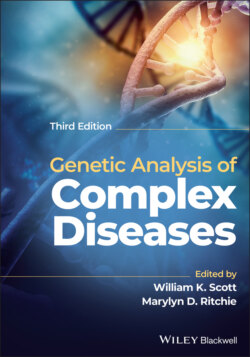Читать книгу Genetic Analysis of Complex Disease - Группа авторов - Страница 69
Ascertainment Bias
ОглавлениеIn genetic studies, research subjects are selected for participation based on the presence or absence of the trait of interest. The family member who comes to the investigator’s attention (through admission to a hospital or solicitation of support groups, for example) is called the proband. Most often, the proband is an individual who exhibits the trait of interest. Ascertainment through an affected individual can lead to a bias in the distribution of the numbers of affected and unaffected family members present in the analysis. Because the ascertainment scheme necessitated that the family have at least one affected individual (proband), families that may be carrying the genetic liability of interest but, by chance, do not contain an affected family member will not be ascertained. This phenomenon is referred to as ascertainment bias and is demonstrated in Figure 3.2. Depending on the analysis, ascertainment bias may greatly influence the outcome of the analyses.
In general, ascertainment bias should not affect the ability to accept or reject linkage in linkage analysis (Chapter 6). However, it can affect the estimate of the recombination fraction between the genetic marker and the disease locus (Vieland and Hodge 1996). Ascertainment bias can also influence familial recurrence risk ratios (λR) (Guo 1998; Cordell and Olson 2000) and the estimate of the segregation probability of the disease locus in segregation analysis (Ewens and Shute 1986; Greenberg 1986; Stene 1989). Furthermore, it has been argued that in some cases, ascertainment bias may be a reasonable explanation for what appears to be genetic anticipation in some pedigrees (Penrose 1948).
Figure 3.2 Example of ascertainment bias in genetic analysis when ascertaining through an affected individual.
Clearly, ignoring the ascertainment scheme used in an analysis can lead to false conclusions. For example, in the fragile X literature, it had been reported that male offspring of premutation and full‐mutation mothers received larger CGG repeat expansions than did female offspring (Rousseau et al. 1994; Loesch et al. 1995). However, once potential sources of ascertainment bias were removed, it was determined that there was no association between sex of the offspring and the size of the mutation inherited from the mother (Ashley‐Koch et al. 1998). In this example, there were three types of ascertainment bias that were sequentially removed from the analysis. First, in clinically ascertained families, the transmission to the proband was removed. This is a standard ascertainment correction known as the Weinberg correction scheme (Weinberg 1912). Second, transmissions were excluded where not all individuals within a sibship were tested. That is, in fragile X families, nonsymptomatic females are tested more often than nonsymptomatic males because only the females are at risk to have affected offspring. This ascertainment bias increases the number of transmissions to premutation females compared with premutation males. Finally, the transmissions of the CGG repeat to the mothers of the proband were omitted. Because full‐mutation females have reduced fitness (Sherman et al. 1984), mothers of probands are more likely to be premutation carriers merely because they have reproduced. Consequently, including transmissions of the CGG repeat from carrier grandmothers to mothers of probands will also increase the number of transmissions to premutation females. Table 3.1 shows how sequentially correcting for the ascertainment bias in fragile X families changes the conclusion regarding the association between offspring sex and the size of the CGG expansion. Notice that the statistical tests (t‐test and logistic regression) become insignificant as the correction schemes are applied. Additionally, it illustrates that in some cases, standard correction schemes, such as the Weinberg method, are not sufficient to abolish the bias in the ascertainment scheme. Thus, all potential sources of bias in the data set must be carefully considered.
Table 3.1 Association between sex of offspring and risk of expansion in fragile X syndrome.
Source: From Ashley‐Koch et al. (1998); reprinted with permission.
| Proportion of offspring with full mutation (%) | P‐value | |||
|---|---|---|---|---|
| Ascertainment scheme (no. of cases) | Males | Females | t‐test | Logistic regression |
| Removal of cases associated with ascertainment (434) | 0.46 | 0.38 | 0.06 | 0.07 |
| Removal of incompletely ascertained sibships (338) | 0.48 | 0.43 | 0.38 | 0.34 |
| Removal of transmissions to proband’s mother (298) | 0.48 | 0.50 | 0.63 | 0.71 |
